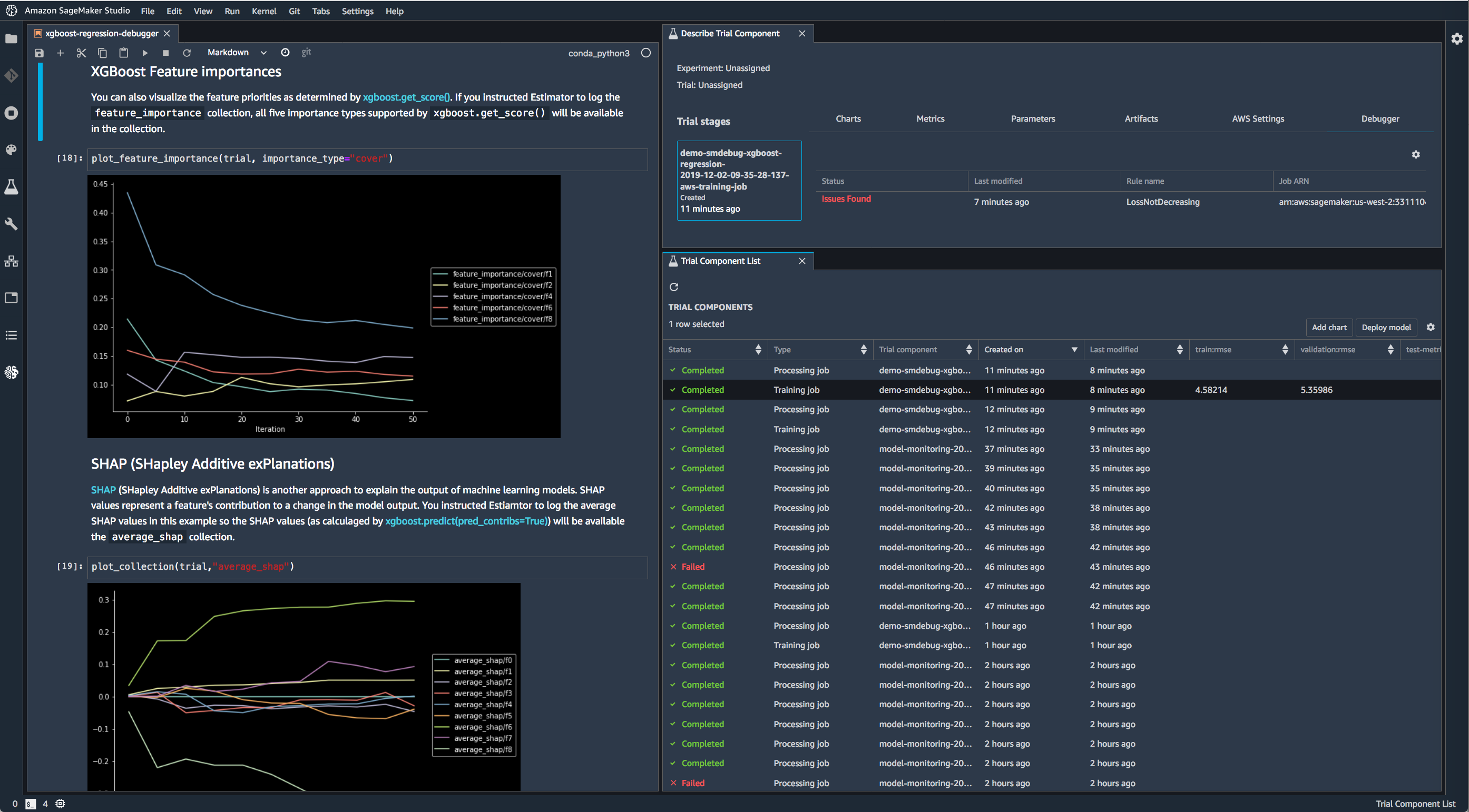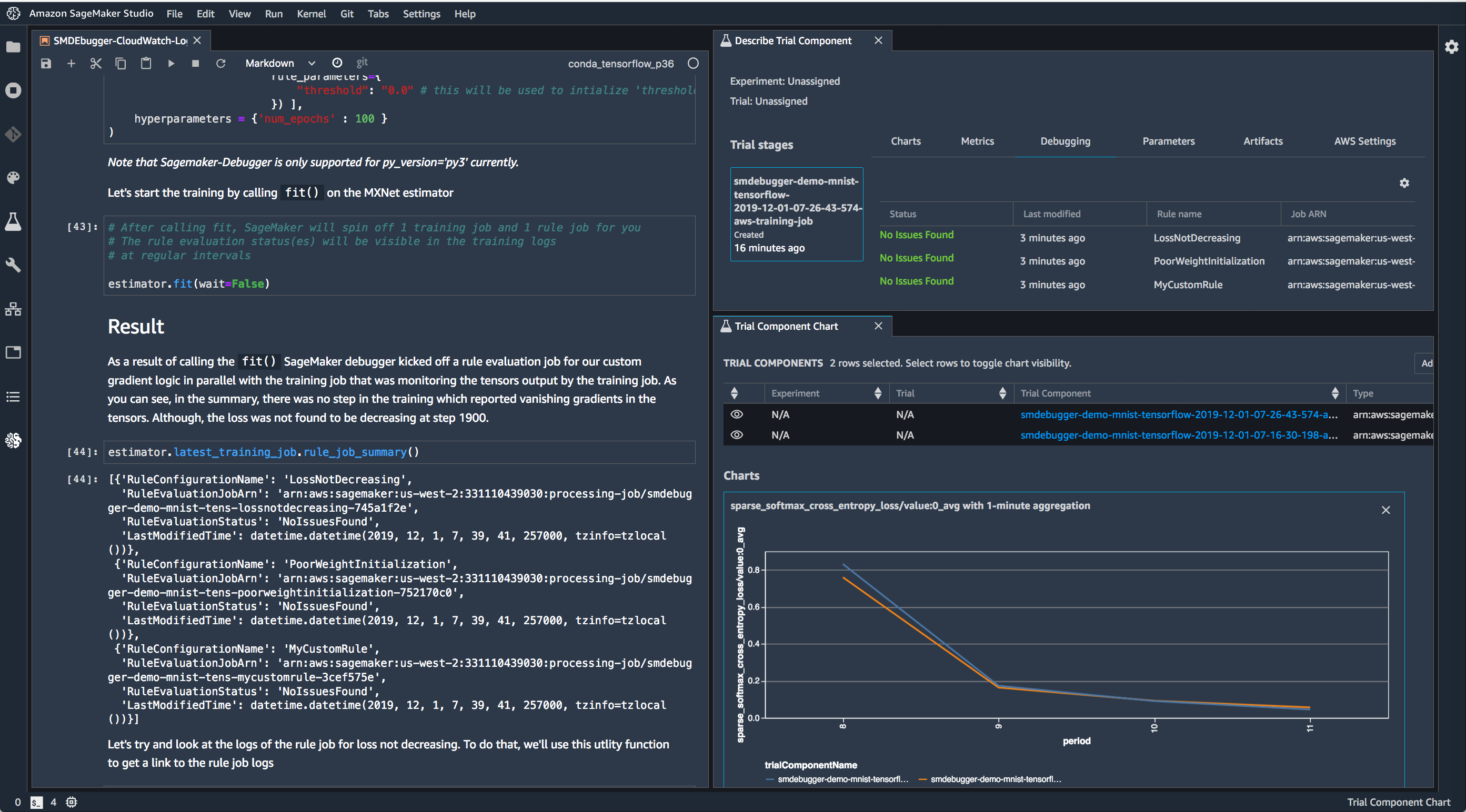Amazon SageMaker Debugger is an offering from AWS which help you automate the debugging of machine learning training jobs. This library powers Amazon SageMaker Debugger, and helps you develop better, faster and cheaper models by catching common errors quickly. It allows you to save tensors from training jobs and makes these tensors available for analysis, all through a flexible and powerful API. It supports TensorFlow, PyTorch, MXNet, and XGBoost on Python 3.6+.
- Zero Script Change experience on SageMaker when using supported containers
- Full visibility into any tensor part of the training process
- Real-time training job monitoring through Rules
- Automated anomaly detection and state assertions through built-in and custom Rules on SageMaker
- Actions on your training jobs based on the status of Rules
- Interactive exploration of saved tensors
- Distributed training support
- TensorBoard support
We have a bunch of example notebooks here demonstrating different functionality of SageMaker Debugger.
This example uses a zero-script-change experience, where you can use your training script as-is. Refer Running SageMaker jobs with Amazon SageMaker Debugger for more details on this.
import sagemaker as sm
from sagemaker.debugger import rule_configs, Rule, CollectionConfig
# Choose a built-in rule to monitor your training job
rule = Rule.sagemaker(
rule_configs.exploding_tensor(),
# configure your rule if applicable
rule_parameters={"tensor_regex": ".*"},
# specify collections to save for processing your rule
collections_to_save=[
CollectionConfig(name="weights"),
CollectionConfig(name="losses"),
],
)
# Pass the rule to the estimator
sagemaker_simple_estimator = sm.tensorflow.TensorFlow(
entry_point="script.py",
role=sm.get_execution_role(),
framework_version="1.15",
py_version="py3",
# argument for smdebug below
rules=[rule],
)
sagemaker_simple_estimator.fit()
tensors_path = sagemaker_simple_estimator.latest_job_debugger_artifacts_path()
import smdebug.trials as smd
trial = smd.create_trial(out_dir=tensors_path)
print(f"Saved these tensors: {trial.tensor_names()}")
print(f"Loss values during evaluation were {trial.tensor('CrossEntropyLoss:0').values(mode=smd.modes.EVAL)}")That's it! Amazon SageMaker will automatically monitor your training job for you with the Rules specified and create a CloudWatch event which tracks the status of the Rule, so you can take any action based on them.
If you want greater configuration and control, we offer that too. Head over here for more information.
Requires Python 3.6+, and this example uses tf.keras. Run
pip install smdebug
To use Amazon SageMaker Debugger, simply add a callback hook:
import smdebug.tensorflow as smd
hook = smd.KerasHook(out_dir='~/smd_outputs/')
model = tf.keras.models.Sequential([ ... ])
model.compile(
optimizer='adam',
loss='sparse_categorical_crossentropy',
)
# Add the hook as a callback
model.fit(x_train, y_train, epochs=2, callbacks=[hook])
model.evaluate(x_test, y_test, callbacks=[hook])
# Create a trial to inspect the saved tensors
trial = smd.create_trial(out_dir='~/smd_outputs/')
print(f"Saved these tensors: {trial.tensor_names()}")
print(f"Loss values during evaluation were {trial.tensor('CrossEntropyLoss:0').values(mode=smd.modes.EVAL)}")Amazon SageMaker Debugger uses the construct of a Hook to save the values of requested tensors throughout the training process. You can then setup a Rule job which simultaneously monitors and validates these tensors to ensure
that training is progressing as expected.
A rule might check for vanishing gradients, or exploding tensor values, or poor weight initialization. Rules are attached to CloudWatch events, so that when a rule is triggered it changes the state of the CloudWatch event. You can configure any action on the CloudWatch event, such as to stop the training job saving you time and money.
Amazon SageMaker Debugger can be used inside or outside of SageMaker. However the built-in rules that AWS provides are only available for SageMaker training. Scenarios of usage can be classified into the following:
- SageMaker Zero-Script-Change: Here you specify which rules to use when setting up the estimator and run your existing script, no changes needed. See the first example above.
- SageMaker Bring-Your-Own-Container: Here you specify the rules to use, and modify your training script minimally to enable SageMaker Debugger.
- Non-SageMaker: Here you write custom rules (or manually analyze the tensors) and modify your training script minimally to enable SageMaker Debugger. See the second example above.
The reason for different setups is that SageMaker Zero-Script-Change (via AWS Deep Learning Containers) uses custom framework forks of TensorFlow, PyTorch, MXNet, and XGBoost which add our Hook to the training job and save requested tensors automatically. These framework forks are not available in custom containers or non-SM environments, so you must modify your training script in these environments.
| Section | Description |
|---|---|
| SageMaker Training | SageMaker users, we recommend you start with this page on how to run SageMaker training jobs with SageMaker Debugger |
| Frameworks | See the frameworks pages for details on what's supported and how to modify your training script if applicable |
| APIs for Saving Tensors | Full description of our APIs on saving tensors |
| Programming Model for Analysis | For description of the programming model provided by our APIs which allows you to perform interactive exploration of tensors saved as well as to write your own Rules monitoring your training jobs. |
- Using SageMaker Debugger with XGBoost in SageMaker Studio to save feature importance values and plot them in a notebook during training.

- Using SageMaker Debugger with TensorFlow in SageMaker Studio to run built-in rules and visualize the loss.

This library is licensed under the Apache 2.0 License.